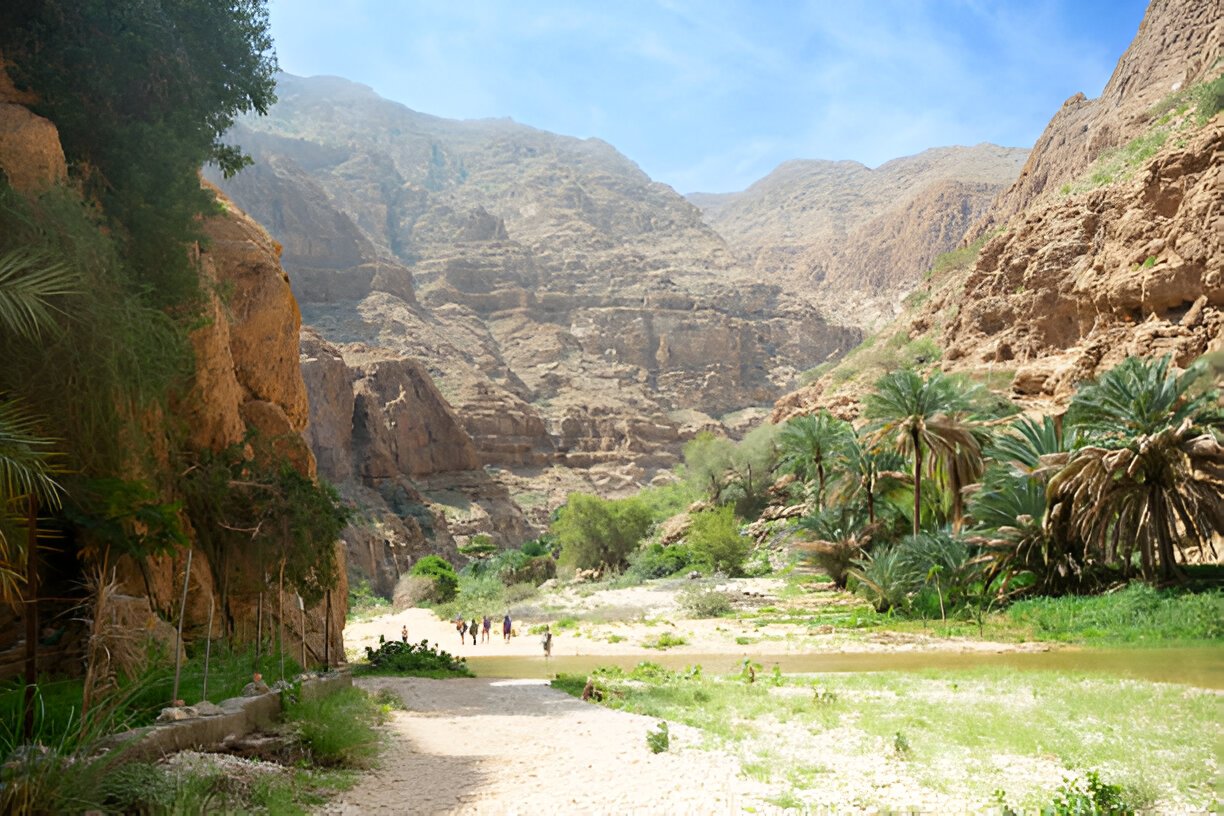

The Omani Khanjar is steeped in history, dating back several centuries. It’s more than just a tool for self-defense—it’s a symbol of valor, honor, and the rich cultural heritage of Oman. The history of the Omani Khanjar is as old as the nation itself, with its origins tracing back to the early Arab tribes that inhabited the region. Initially, it was used as a weapon, but over time, it evolved into a symbol of status and nobility.
The Omani Khanjar is not just a weapon; it's a bridge connecting generations, carrying with it stories of bravery, honor, and an unwavering commitment to heritage.
The origins of the Omani Khanjar can be traced to the early days of Oman when the dagger was primarily used in combat. However, as time passed, the Omani Khanjar became more than just a weapon; it became a symbol of authority and respect. The dagger’s design has remained remarkably consistent, with slight variations that reflect regional differences within Oman. These variations have only added to the Khanjar’s cultural richness, making each piece unique and reflective of the area it originates from.
The Khanjar’s shape, a curved blade with a sharp tip, has a deep symbolic meaning. The curve represents the crescent moon, a significant symbol in Islamic culture, while the sharpness of the blade signifies readiness and the warrior spirit. Even though the Omani Khanjar is no longer used in battle, its shape and design continue to be a powerful reminder of Oman’s martial past.
In the curve of each blade lies a tale of valor, woven into the fabric of Omani history. The Khanjar is more than steel; it is a symbol of the nation's heart and soul.
In Omani society, the Omani Khanjar is more than just a decorative piece; it is a powerful cultural symbol. It is worn with traditional attire during significant events such as weddings, religious celebrations, and national ceremonies. The Khanjar signifies manhood and is often handed down from father to son, serving as a family heirloom that connects generations. This practice highlights the Khanjar’s role not just as a weapon, but as a vessel of cultural and familial continuity.
The Khanjar is a silent witness to Oman's most significant moments, from the vows of a wedding to the celebrations of national pride. It is a symbol that speaks louder than words.
Wearing the Omani Khanjar during public ceremonies and national events is seen as a mark of respect and pride. It represents the values that Omanis hold dear—honor, courage, and loyalty. In many ways, the Khanjar is a reflection of the Omani identity itself, embodying the spirit of a nation that values its traditions while also embracing modernity.
The Omani Khanjar is so deeply ingrained in the country’s identity that it features prominently in various national symbols. For instance, the Khanjar is a central element of Oman’s national emblem, which also includes crossed swords and a crown. This emblem is displayed on official documents, government buildings, and military uniforms, underscoring the importance of the Khanjar in the national consciousness.
Moreover, the Khanjar is also depicted in Omani currency, further solidifying its role as a national symbol. The presence of the Omani Khanjar on the nation’s currency is a testament to its value as a cultural and historical artifact. It reminds every Omani of the enduring legacy of their ancestors and the importance of preserving their heritage.
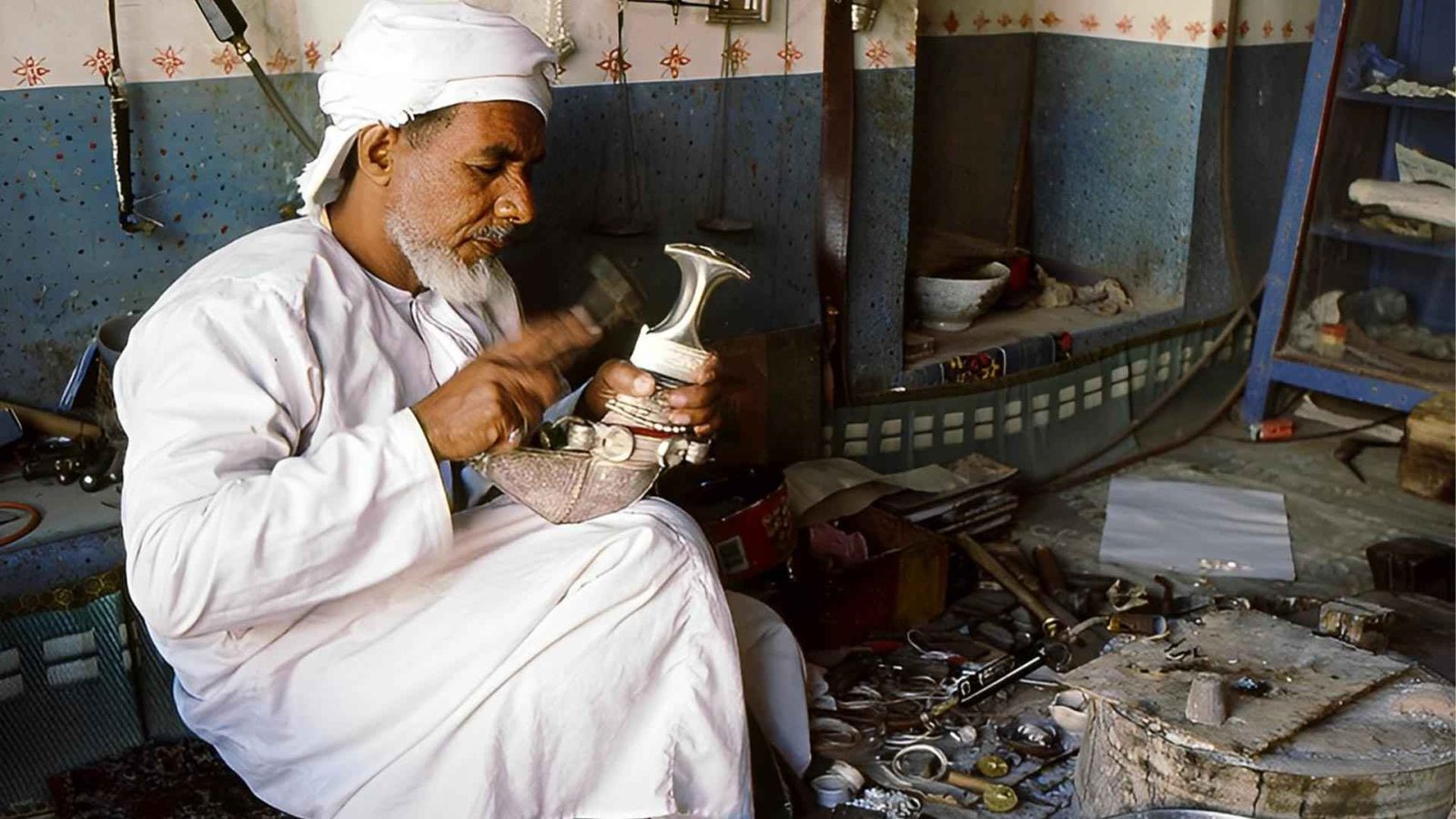
The craftsmanship of the Omani Khanjar is a testament to the skill and dedication of Omani artisans. Each Khanjar is handcrafted with meticulous attention to detail, reflecting the pride that these craftsmen take in their work. The process of making a Khanjar is a lengthy and intricate one, requiring years of training and experience to master.
The materials used in the making of an Omani Khanjar are carefully selected to ensure both durability and beauty. The blade is typically forged from high-quality steel, known for its strength and sharpness. In some cases, the blade may be made from Damascus steel, a material prized for its distinctive patterns and superior resilience.
The hilt, or handle, of the Khanjar is often crafted from a variety of materials, including wood, ivory, or horn. Some of the most prized Khanjars feature hilts made from rhino horn or sandalwood, both of which are known for their durability and aesthetic appeal. The hilt is usually intricately carved, with designs that can range from simple geometric patterns to elaborate floral motifs.
The sheath, which covers the blade, is another important component of the Omani Khanjar. It is usually made from leather and is often embellished with silver or gold. The sheath not only protects the blade but also serves as a canvas for artistic expression. Silverwork on the sheath is a hallmark of Omani craftsmanship, with artisans using techniques that have been passed down through generations.
The art of Khanjar-making is a revered tradition in Oman, with each step of the process requiring precision and expertise. The process begins with forging the blade, which involves heating the steel until it is malleable and then shaping it into the distinctive curved form of the Khanjar. This is followed by tempering, a process that involves reheating and cooling the blade to improve its hardness and durability.
Once the blade is forged, the hilt is attached. This is often the most time-consuming part of the process, as the hilt must be carefully shaped and fitted to the blade. The handle is then decorated with intricate carvings, adding to the Khanjar’s aesthetic appeal.
The final step in the creation of an Omani Khanjar is the making of the sheath. This involves stitching the leather around a wooden core and then decorating it with silver or gold. The designs on the sheath often reflect the region of Oman from which the Khanjar originates, with each area having its own distinctive style.
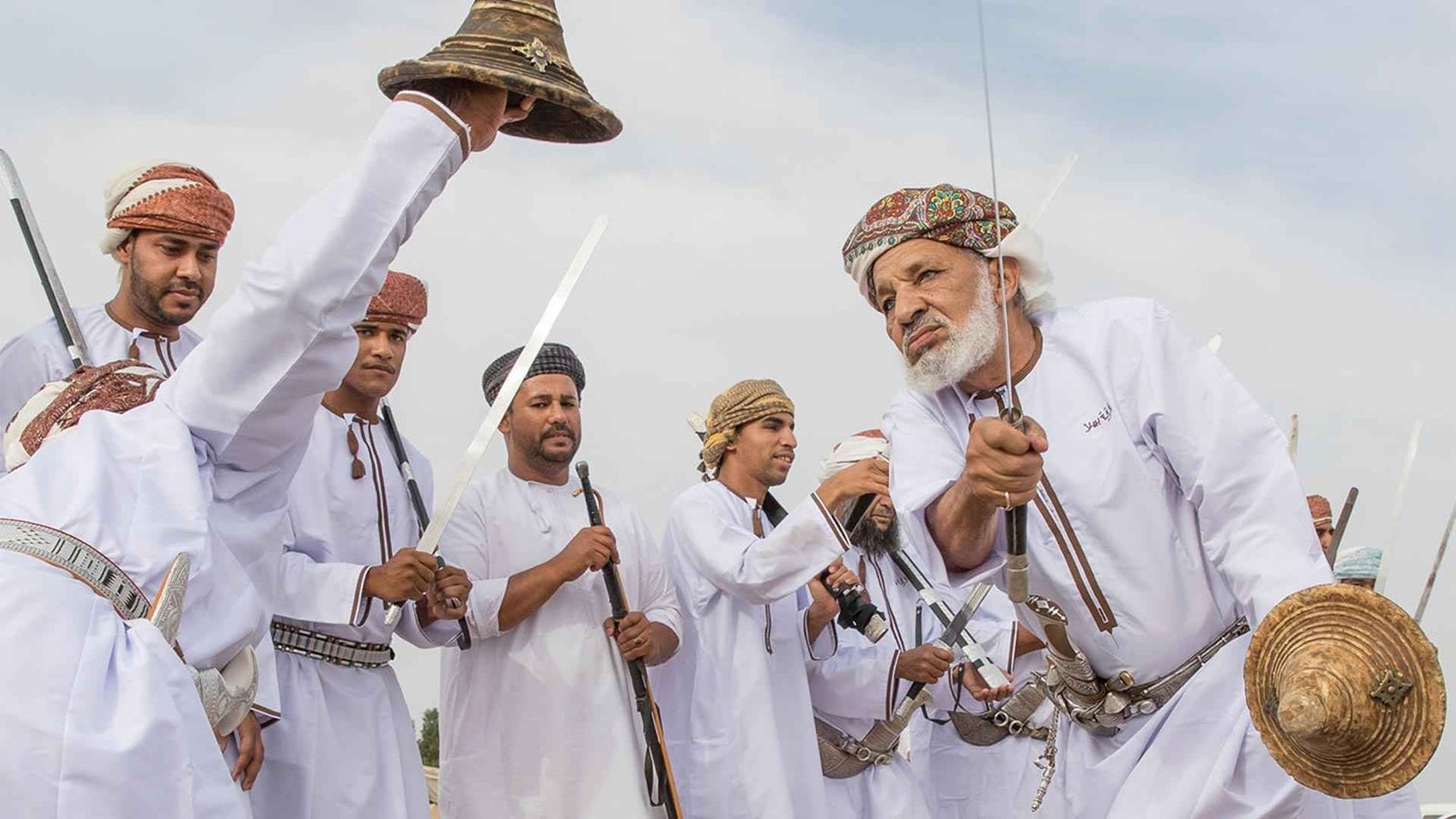
The Omani Khanjar is deeply embedded in the cultural practices of Oman. It is worn with traditional attire during important events such as weddings, religious celebrations, and national ceremonies. The Khanjar signifies manhood and is often handed down from father to son, serving as a family heirloom that connects generations.
In Omani weddings, for example, the Khanjar plays a central role. It is often worn by the groom as a symbol of his readiness to take on the responsibilities of marriage. The Khanjar is also featured in traditional dances, where it is used as a prop to emphasize the warrior spirit of the Omani people.
During religious celebrations, the Omani Khanjar is worn as part of the traditional attire, symbolizing the wearer’s respect for Omani customs and traditions. The Khanjar is also worn during national ceremonies, where it serves as a reminder of Oman’s rich cultural heritage.
The Omani Khanjar is a prominent feature in many of Oman’s festivals and ceremonies. During the annual National Day celebrations, for example, the Khanjar is worn by men as a symbol of national pride. The sight of hundreds of men dressed in traditional attire, with their Khanjars proudly displayed, is a powerful reminder of the importance of tradition in Omani society.
The Khanjar is also worn during religious festivals such as Eid, where it is seen as a symbol of purity and honor. During these festivals, the Khanjar is often displayed in public places, with its intricate designs admired by all who see it.
In addition to national and religious ceremonies, the Khanjar is also worn during more personal celebrations, such as weddings. In these settings, the Khanjar is a symbol of the groom’s readiness to take on the responsibilities of marriage and is often given as a gift to mark the occasion.
The Omani Khanjar is typically worn with a specially designed belt, known as the “Hizan.” This belt is not just a practical accessory; it is an integral part of traditional Omani attire. The Hizan is usually made from high-quality leather and is often decorated with elaborate silver or gold embroidery. The belt is designed to hold the Khanjar securely in place, ensuring that it can be worn comfortably during long ceremonies or celebrations.
The design of the Hizan varies depending on the region of Oman. In some areas, the belt may feature intricate patterns and designs, while in others, it may be more understated. Regardless of its design, the Hizan is always crafted with great care, reflecting the importance of the Khanjar in Omani culture.
Wearing the Omani Khanjar with its accompanying belt is a tradition that has been passed down through generations. It is a way for Omani men to honor their heritage and to demonstrate their connection to the values and traditions of their ancestors. The Khanjar and Hizan together create a powerful visual symbol of Omani identity.
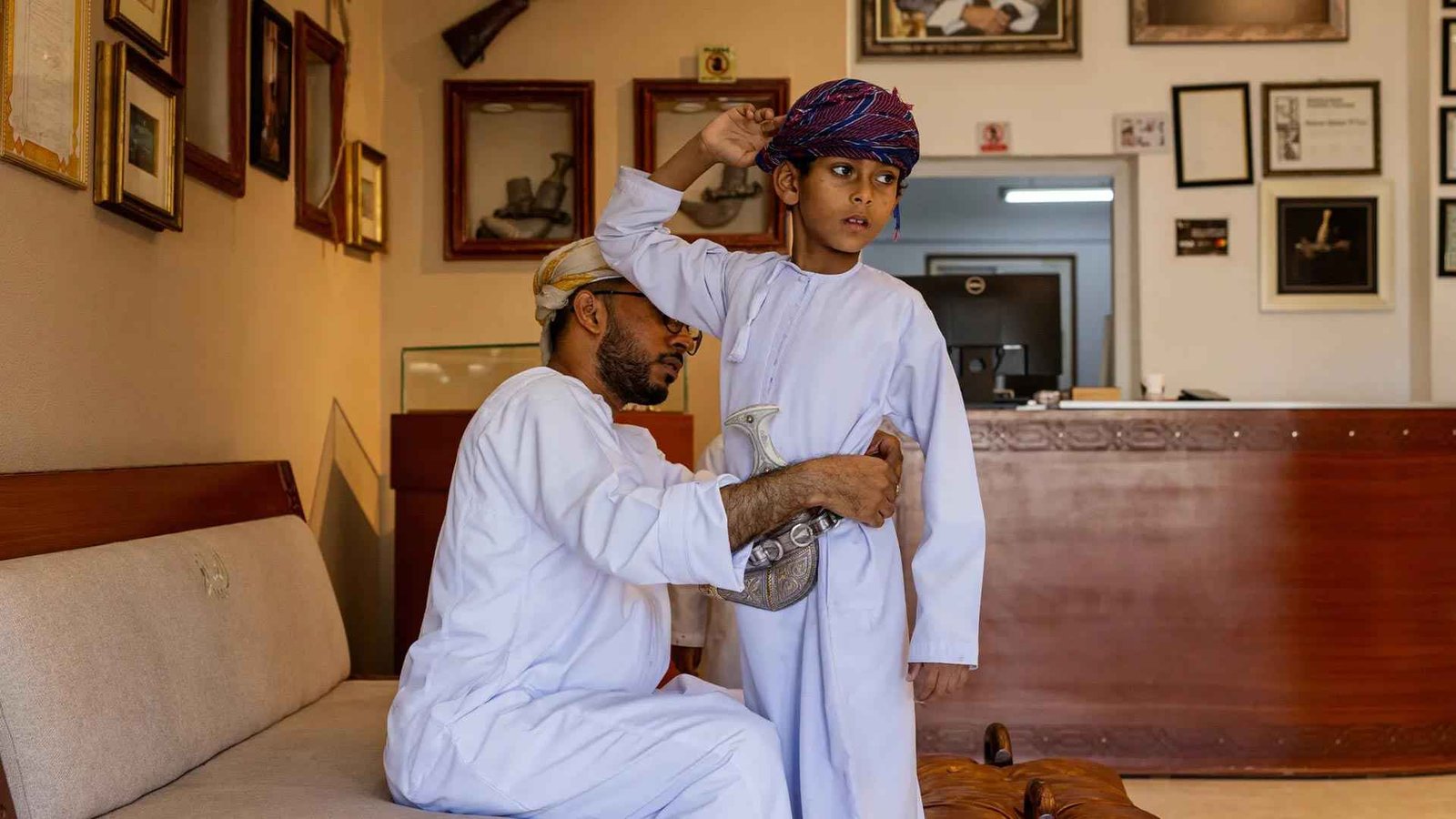
While the Omani Khanjar is deeply rooted in tradition, its significance extends well into the present day. In modern Oman, the Khanjar continues to be a symbol of national pride, but its role has evolved alongside the changing cultural landscape. For many young Omanis, the Khanjar represents a tangible link to their heritage—an embodiment of the values and history passed down through generations.
The way young Omanis perceive the Khanjar varies widely, reflecting the diversity of perspectives within the country. For some, the Khanjar is a cherished family heirloom, a physical representation of their ancestors’ bravery and honor. It is often displayed proudly in their homes or worn during special occasions as a reminder of their cultural identity.
Others see the Khanjar as more than just a traditional artifact—it has become a fashion statement, integrated into modern Omani attire in innovative ways. Young designers are reinterpreting the Khanjar, incorporating its motifs into contemporary clothing, jewelry, and accessories. This fusion of old and new allows the Khanjar to remain relevant in a rapidly modernizing society.
In recent years, the Omani Khanjar has made a notable appearance in the fashion industry, both within Oman and internationally. Designers have begun to experiment with the Khanjar’s iconic shape and symbolism, creating collections that pay homage to this traditional dagger while appealing to modern tastes.
For instance, during national celebrations like Oman’s National Day, it’s not uncommon to see young men and women wearing clothing adorned with Khanjar-inspired designs. These outfits blend traditional elements with contemporary fashion, allowing the wearers to express their pride in their heritage in a modern context.
Furthermore, accessories such as necklaces, cufflinks, and brooches featuring miniaturized Khanjars have become popular among the younger generation. These items serve as subtle yet powerful symbols of cultural pride, bridging the gap between tradition and modernity.
In today's Oman, the Khanjar has found a new voice in fashion, blending tradition with modern elegance, and allowing the younger generation to carry forward this proud legacy.
Beyond its role in fashion, the Omani Khanjar serves as a cultural ambassador, representing Oman on the global stage. It is often featured in exhibitions, cultural exchanges, and diplomatic gifts, showcasing the richness of Omani heritage to the world. For young Omanis living abroad, the Khanjar can also be a way to stay connected to their roots, symbolizing their identity in a foreign land.
When the Khanjar is gifted on the international stage, it is not just a gesture; it is a piece of Oman, a story of our people and our pride, shared with the world.
As Oman continues to modernize, efforts are being made to ensure that the Khanjar remains relevant to all generations. Educational programs, cultural festivals, and media campaigns highlight the importance of the Khanjar, encouraging young Omanis to appreciate and uphold this aspect of their cultural heritage.
For many, the Khanjar is not just a relic of the past but a living symbol of Omani identity. Its continued presence in both traditional ceremonies and modern expressions of culture demonstrates its enduring significance, making it a timeless emblem of Omani pride.
As we move forward, the Khanjar will continue to be a symbol of Oman's strength and resilience, reminding us of where we come from and where we are headed.
Over the centuries, the Omani Khanjar has undergone various changes, both in its design and in its cultural significance. While the basic shape and structure of the Khanjar have remained consistent, there have been some notable evolutions in the materials used and the level of craftsmanship.
In the past, the Khanjar was primarily made from materials that were readily available in Oman, such as local wood and leather. However, as trade routes expanded and Oman became more connected with the outside world, new materials began to be incorporated into the design of the Khanjar. Today, it is not uncommon to find Khanjars that feature materials such as ivory, precious metals, and even gemstones.
These modern influences have added new dimensions to the Omani Khanjar, making it not only a symbol of tradition but also a piece of art that can be customized to reflect the personal tastes of the wearer. Despite these changes, the Khanjar has retained its core identity as a symbol of Omani heritage, and its cultural significance remains as strong as ever.
The art of Khanjar-making has evolved over time, influenced by both internal innovations and external interactions. Modern tools and techniques have made it possible to create Khanjars with even greater precision and detail than was possible in the past. However, many artisans still prefer to use traditional methods, believing that these techniques are what give the Omani Khanjar its unique character.
One of the most significant modern influences on Khanjar craftsmanship is the introduction of new materials. While the traditional Khanjar was typically made from local resources, today’s artisans have access to a wide range of materials from around the world. This has allowed for greater creativity in the design and construction of the Khanjar, with some modern pieces featuring intricate inlays of gold, silver, and even precious stones.
Despite these innovations, the essence of the Omani Khanjar remains unchanged. It continues to be a symbol of pride and heritage, reflecting the rich cultural history of Oman. The balance between tradition and modernity is what makes the Khanjar such a unique and enduring symbol.
Preserving the tradition of Khanjar-making is essential for maintaining Oman’s cultural heritage. Various efforts have been made to ensure that this ancient craft is passed down to future generations, keeping the art of Khanjar-making alive.
One of the key initiatives in this regard is the establishment of workshops and training centers where young Omanis can learn the skills needed to craft a Khanjar. These programs are often supported by the government, which recognizes the importance of preserving this unique aspect of Omani culture. By providing training and resources to aspiring craftsmen, these initiatives help to ensure that the tradition of Khanjar-making will continue to thrive.
In addition to formal training programs, some numerous cultural festivals and exhibitions celebrate the Omani Khanjar. These events provide a platform for artisans to showcase their work and to educate the public about the history and significance of the Khanjar. They also serve as a reminder of the importance of preserving Oman’s cultural heritage in an increasingly globalized world.
Another important aspect of preservation is the documentation of Khanjar-making techniques and traditions. This includes recording the stories and methods of master craftsmen, many of whom have spent their entire lives perfecting the art of making a Khanjar. By documenting these practices, future generations will have a valuable resource to learn from, even as the world around them continues to change.
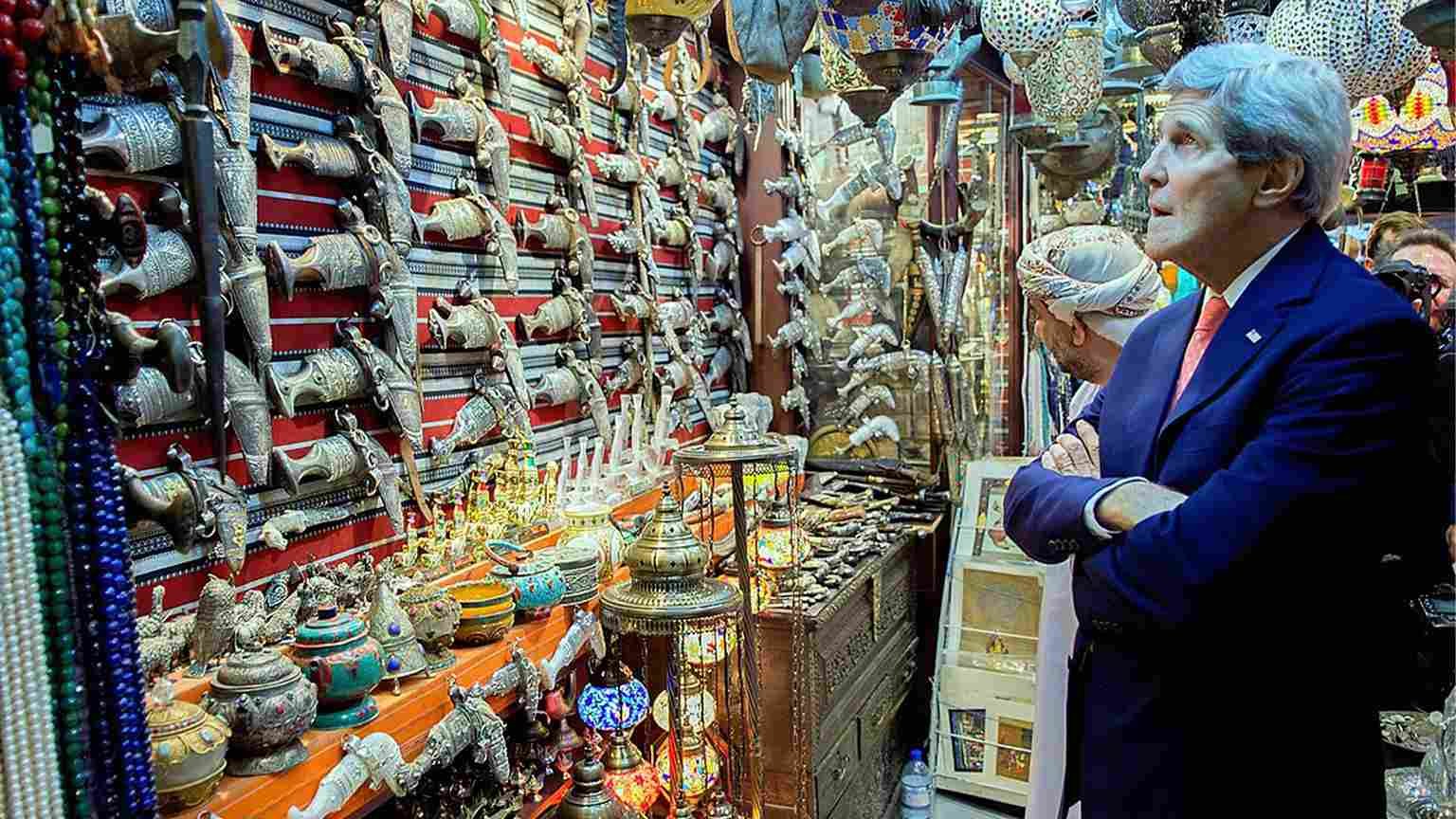
If you’re interested in purchasing an authentic Omani Khanjar, several reputable sellers across Oman offer a range of options. Whether you’re looking for a traditional handcrafted Khanjar or a modern interpretation, it’s essential to ensure that you’re buying from a trustworthy source. Local markets such as Muttrah Souq in Muscat and Nizwa Souq are popular places to find high-quality Khanjars. Online platforms like Omani handicrafts websites also provide a selection of authentic Khanjars, with options for international shipping.
Pricing and Value: The price of a Khanjar can vary widely depending on factors such as the materials used, the intricacy of the design, and the reputation of the craftsman. Basic models might start at a few hundred Omani Rials, while antique or custom-made Khanjars can reach into the thousands.
Authenticity Check: When purchasing a Khanjar, look for hallmark features like the quality of the silverwork on the sheath and the sharpness of the blade. Avoid overly polished or uniform designs, which may indicate mass production. Always ask for a certificate of authenticity, especially when purchasing high-value items.
Owning a Khanjar is a responsibility that comes with the need for proper maintenance. To keep your Khanjar in pristine condition, it’s essential to follow these care guidelines:
Cleaning: Regularly clean the blade with a soft cloth to remove any moisture or fingerprints, which can cause rust. If the blade is made of Damascus steel, consider applying a light coat of oil to prevent oxidation.
Polishing: The silver or gold embellishments on the sheath should be polished with a non-abrasive cloth to maintain their shine. Avoid using harsh chemicals that might damage the intricate designs.
Storage: Store your Khanjar in a cool, dry place, preferably in a display case that protects it from dust and humidity. The sheath should always cover the blade to prevent accidental damage.
By taking these steps, you ensure that your Omani Khanjar remains a beautiful and functional piece of Omani heritage for years to come.
The Omani Khanjar is not a monolithic object; its design and craftsmanship can vary significantly depending on the region of Oman where it was made. For example:
Muscat Khanjars: Known for their intricate silverwork and elaborate designs, Muscat Khanjars are often more ornate and are considered highly valuable.
Nizwa Khanjars: These are typically simpler in design but are known for their durability and the steel quality used in the blade.
Sur Khanjars: Sur Khanjars often feature unique hilt designs made from rare materials like rhino horn, making them a prized possession among collectors.
When choosing a Khanjar, consider what aspects are most important to you—whether it’s the craftsmanship, the materials, or the cultural significance of the region where it was made.
The Omani Khanjar is much more than just a dagger; it is a symbol of Oman’s rich cultural heritage, embodying the values of honor, bravery, and loyalty that have defined the Omani people for centuries. From its origins as a practical weapon to its current status as a cherished cultural artifact, the Khanjar has played a central role in the history and identity of Oman.
Throughout this article, we’ve explored the history of the Omani Khanjar, its significance in Omani culture, and the intricate craftsmanship that goes into its creation. We’ve also looked at the ways in which the Khanjar has evolved over time, adapting to modern influences while retaining its core identity. Finally, we’ve discussed the importance of preserving this ancient tradition, ensuring that the art of Khanjar-making continues to thrive for generations to come.
As Oman continues to modernize, the Omani Khanjar remains a steadfast reminder of the country’s rich history and cultural traditions. It serves as a link between the past and the present, connecting Omanis to their heritage and reinforcing their sense of identity. In a world that is constantly changing, the Khanjar stands as a symbol of the enduring values that have shaped Oman and its people.
The Omani Khanjar is typically made from high-quality steel for the blade, with the hilt often crafted from materials such as wood, ivory, or horn. The sheath is usually made from leather and may be embellished with silver or gold.
The Omani Khanjar continues to be a symbol of pride and heritage in modern Oman. It is worn during important events and is featured in national symbols, reflecting its enduring cultural significance.
While the basic design of the Khanjar has remained consistent, modern influences have introduced new materials and techniques, allowing for greater creativity in its construction. Despite these changes, the Khanjar remains a symbol of Omani tradition.
Various initiatives, including workshops, training programs, and cultural festivals, are in place to preserve the tradition of Khanjar-making. These efforts ensure that the skills and knowledge associated with this craft are passed down to future generations.
Never miss any important news. Subscribe to our newsletter.



